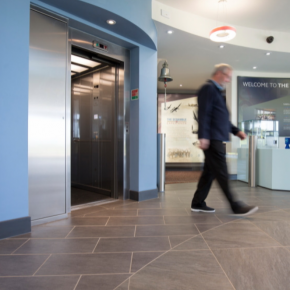
Stannah: The importance of lift servicing for lift owners
Being a responsible lift owner or building manager, you have a duty to ensure that your lift is safe to use. With this in mind, it’s critical that lift servicing is carried out regularly. How often lifts require inspecting or servicing depends on the type, usage frequency and the number of floors. A lift, throughout its life, should require regular lift servicing, routine lift inspections (statutory or otherwise) and a programme of planned preventative maintenance in place. Stannah has more…
How often should a lift be serviced?
While current UK law requires a lift service or maintenance visit at least every six months if the installation is carrying passengers and once every 12 months if the lift is used only for goods, these are minimum requirements and need viewing as such.
Low usage passenger carrying lifts may only require two services a year to fulfil legal requirements. In contrast, high-frequency use installations in larger and more frequented premises may need more regular servicing to prevent costly breakdowns and possible interruptions to service.
As lifts contain mechanical components, they are prone to wear and tear. In addition, electronic systems may need re-programming, and safety systems should be regularly checked. Sometimes additional preventative maintenance may be prudent and necessary to achieve optimum performance and minimise the risk of downtime.
What is lift servicing?
Lift servicing is where an engineer undertakes a planned preventative maintenance programme as agreed with you; doing so helps to prevent costly breakdowns through regular checks and replacement of worn parts to keep your lift performing at maximum efficiency. Most independent lift companies, like Stannah, maintain and service all types, makes and models of lifts.
What type of checks are involved?
The regular checks include detailed inspections of the interior and exterior of the lift car, as well as checks in the machine room or control panel, the pit, and the lift shaft. Depending on the service interval, a standard service visit from a reputable provider could include some of the following checks:
– Landing and car doors and their interlock
– Shaft structure
– Main drive system components
– Signs, locks and keys
– Suspension ropes and chains
– Overload detection devices
– Electrical devices (including earthing, earth bonding, safety devices, selection of fuses, etc.)
– Braking systems (including buffers and overspeed devices)
– Alarms and communication equipment
– Lubrication and smooth functioning
– Emergency backup and communication system
This list is not exhaustive. Hydraulic installations and traction systems may require further system tests.
What does a service visit involve?
During a service visit, an engineer will check the safety features of the lift, as well as clean, lubricate and adjust all components for optimum performance. A Stannah engineer would then complete a service screen on his laptop, stating the work carried out and detailing any comments, such as suggested repairs or works of improvement not covered by the contract. A report should be issued after each engineer visit as a maintenance record.
What legislation do I need to comply with?
Insurers will typically require copies of documentation and service history, plus compliance with the following current legislation;
LOLER (Lifting Operations and Lifting Equipment Regulations 1998)
The Equality Act 2010 (to accommodate the mobility needs of disabled persons)
PUWER (The Provision and Use of Work Equipment Regulations 1998)
Will my lift be out of action while an inspection or service is taking place?
Yes. The engineer will need to check many items within the shaft/structure and motor room, so the lift will be ‘out of service’ while the engineer is on-site.
Visit Supplier's page
Latest news

26th July 2024
Enfield Speciality Doors completes world-class project for Atlas Copco HQ
A rundown office and warehouse building completely transformed into a modern headquarters for Atlas Copco has been fitted with more than 120 internal fire doors from Enfield Speciality Doors.
Posted in Access Control & Door Entry Systems, Articles, Building Industry News, Building Products & Structures, Building Systems, Case Studies, Doors, Interior Design & Construction, Interiors, Posts, Restoration & Refurbishment, Retrofit & Renovation, Security and Fire Protection, Sustainability & Energy Efficiency, Timber Buildings and Timber Products, Wooden products
26th July 2024
Abloy UK launches new white paper
Abloy UK, a leading provider of security and access control solutions, has launched a new white paper.
Posted in Access Control & Door Entry Systems, Architectural Ironmongery, Articles, Building Industry News, Building Products & Structures, Building Services, Doors, Facility Management & Building Services, Health & Safety, Information Technology, Innovations & New Products, Publications, Research & Materials Testing, Security and Fire Protection
26th July 2024
MCRMA Member Profile: David Roy, Director of Roofconsult
David Roy of MCRMA member company Roofconsult has more than 50 years’ experience to draw upon working in the building envelope sector and a unique perspective on how it has changed in that time.
Posted in Articles, BIM, Infrastructure & CAD Software, Building Associations & Institutes, Building Industry News, Building Products & Structures, Building Services, Building Systems, Cladding, Information Technology, Restoration & Refurbishment, Retrofit & Renovation, Roofs, Walls
26th July 2024
Strand: Enhancing Door Functionality and Safety
Craig Fox, Sales Director for Strand Hardware, outlines how door industry professionals might apply door limiting stays…
Posted in Architectural Ironmongery, Articles, Building Industry News, Building Products & Structures, Building Services, Doors, Facility Management & Building Services, Health & Safety, Restoration & Refurbishment, Retrofit & Renovation
 Sign up:
Sign up: 